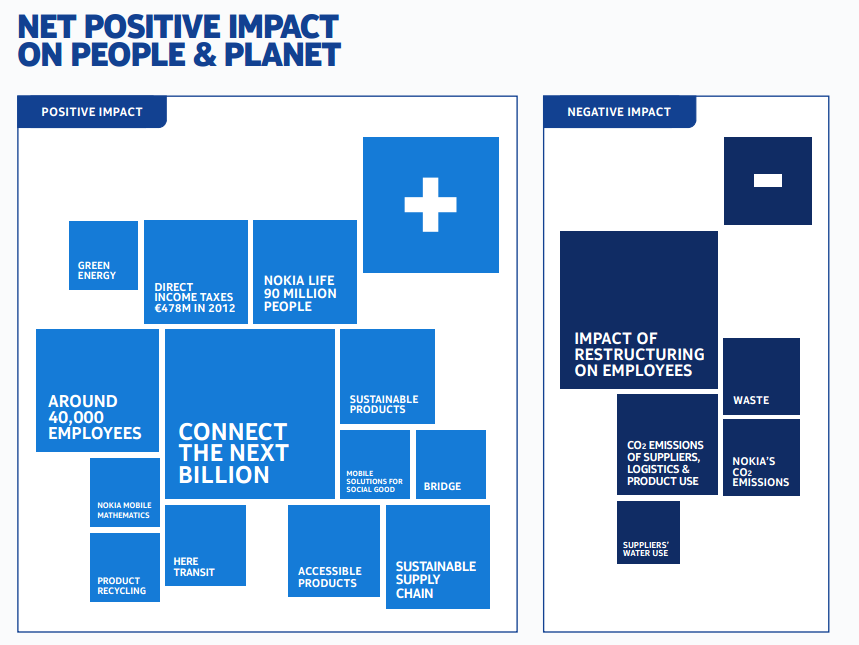Here's how Nokia describe the report:
Since 2002, we’ve consistently reported on corporate responsibility, and each year we build upon our transparency and coverage of issues. Today, our report covers the ethical, socio-economic and environmental areas most relevant to Nokia’s business and its stakeholders.
The Nokia People & Planet Report 2012 is split into Nokia’s efforts for people and the planet. The People section discusses how mobile technology can be harnessed for the good of individuals and communities, but it also covers challenges we faced in 2012 as well as how this impacted our employees and the communities in which we operate. The Planet part reports on our initiatives to minimize the potential negative impacts on the environment and the positive contributions mobile devices can make to the planet. The report is only available in digital format, as we want to print less.
The reports talks in detail about the positive and negative aspects of Nokia's business operations, and details the company's overall performance, whether it met its targets, and plans for the future.

Here are some selected highlights from the report:
Corporate taxation
- Nokia says that, "as a good corporate citizen Nokia pays the amount of tax legally due and observes all applicable rules and regulations in each country where it operates". The report notes that the company has followed the same centralised business model in the allocation of taxable income since the early 1990s. In essence, the majority of profit (and loss) is carried by the business in Finland, with a smaller portion carried in the countries in which Nokia operates. Although it's not specifically mentioned in the report for obvious reasons, this is in sharp contrast to a number of other technology companies who have been in the headlines for offshoring profits in low corporate tax jurisdictions.
Employees
- As a result of Nokia's new strategy (switch to Windows Phone) there were a large number of job losses. In order to help employees affected by the reductions Nokia established a support program call Bridge. By the end of 2012 17,000 employees had participated in the program, and almost 1,000 new businesses have been set up by former employees.
Environmental design
- A dedicated design for environment (DFfE) specialists work actively throughout every product development project at Nokia, verifying legal and voluntary target compliance, as well as promoting sustainable alternatives for materials and other design considerations.
- Over the last decade Nokia has reduced the greenhouse gas footprint of their phones by 50%.
Materials
- In 2012 Nokia banned the used of radioactive substances in all products, packaging, and internal production processes. This in the latest in a long line of substance nad material management policies. For example, the use of perfluorooctanoic acid (PFOA) was restricted, and in 2010 all Nokia products were free from bromine and chlorine compounds related to flame retardants.
- In 2012 Nokia retail packaging material used 18,875 tonnes of paper (on average 52% recycled) and a futher 9,569 tonnes of paper (on average 89% recycled) in transport packaging material.
Chargers
- Over the last 10 years Nokia has reduced the no-load consumption of its chargers by 73% (i.e. charger plugged in, but not being actively used for charging). The best-in-class chargers have seen a 90% reduction.
- The average no-load power consumption on Nokia chargers shipped in 2012 was 0.098W, a reduction of 13% from the previous year.
- In 2012 all new Nokia devices are being shipped with four or five star charger.
Emissions
- 40% of the electricity used by Nokia comes from renewable sources
- Nokia aims to reduce CO2 emissions by a minimum of 30% by 2020 (from a 2006 baseline). The 2013 emissions figure was down 29% from 2006.
- Nokia reduced CO2 emissions from air travel by 54% from 2011 to 2012 in total, and by 39% when calculating reductions per employee. In part this was due to the installation and greater use of new video conferencing facilities.
The full report can be downloaded here [PDF].
